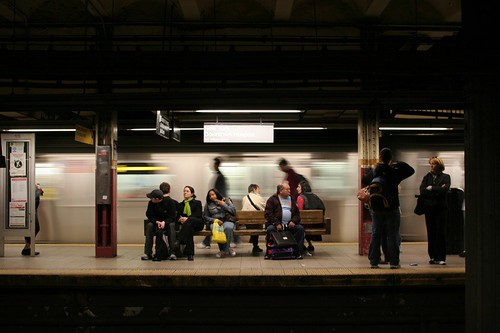 PODCAST #111 Art. Vandalism. Freedom. Blight. Creativity. Crime. Graffiti has divided New Yorkers since it first appeared on walls, signs and lampposts in the late 1960s. Its ascent paralleled the city's sunken financial fortunes, allowing simple markings to evolve into elaborate pieces of art. The only problem? The best examples were on the sides of subway cars which the city promptly attempted to eradicate, their attempts thwarted by clever, creative artists and a downtown culture that was slowly embracing graffiti as New York City's defining art form.
PODCAST #111 Art. Vandalism. Freedom. Blight. Creativity. Crime. Graffiti has divided New Yorkers since it first appeared on walls, signs and lampposts in the late 1960s. Its ascent paralleled the city's sunken financial fortunes, allowing simple markings to evolve into elaborate pieces of art. The only problem? The best examples were on the sides of subway cars which the city promptly attempted to eradicate, their attempts thwarted by clever, creative artists and a downtown culture that was slowly embracing graffiti as New York City's defining art form.This is a history of the battle between graffiti and City Hall. And a look at the aftermath which spawned today's tough city laws and a warehouse space in Queens called 5Pointz, where graffiti masterpieces thrive in abundance today.



 The largest subway system in the United States still does not have security cameras inside its subway cars. Cameras will start filming inside two New York subway cars (as a pilot test) to monitor passengers. The MTA hopes to see a reduction in graffiti inside its trains, which costs the agency $1.8 million per year to remove.
The largest subway system in the United States still does not have security cameras inside its subway cars. Cameras will start filming inside two New York subway cars (as a pilot test) to monitor passengers. The MTA hopes to see a reduction in graffiti inside its trains, which costs the agency $1.8 million per year to remove.Many transit systems, though, which already use cameras within its vehicles still have some intolerable amounts of graffiti and scratchiti. Whether or not the cameras will actually reduce the number of graffiti incidents is debatable. Having cameras on transit, however, has had some successes in identifying suspects of crimes. Here are two:
New York, NY – Though the economy has shown definitive signs of improving as the recession officially starts to end there are still people across the United States living in much harder times than they were just a year ago. The rate of job losses and house 
foreclosures has most decidedly slowed of late but many people are still finding it difficult to make ends meet and are concerned that the jobs may never come back. It is exactly those people, in the best spirit of American entrepreneurship, who are starting to make their own way and make their own jobs.


 The vast cities of London and New York are served by two old, vast subway systems. London of course came first. The line between Paddington and Farringdon opened for service in January 1863. That would have been the same January 1863 in which Abraham Lincoln signed the Emancipation Proclamation.
The vast cities of London and New York are served by two old, vast subway systems. London of course came first. The line between Paddington and Farringdon opened for service in January 1863. That would have been the same January 1863 in which Abraham Lincoln signed the Emancipation Proclamation.New York's system is a relative baby. Though there were predecessor train lines, both under and above the ground, the commonly accepted beginning of the subway system is October 1904, when the IRT line opened between City Hall and 145th Street/Broadway. The Russo-Japanese War was going strong then.
There are loads of good histories of both systems, but what follows here is a comparison of the two systems based on personal observation. I've rode the NY Subway since forever, and have seen and used the London Underground a number of times since I first travelled on it in the 1970s.
